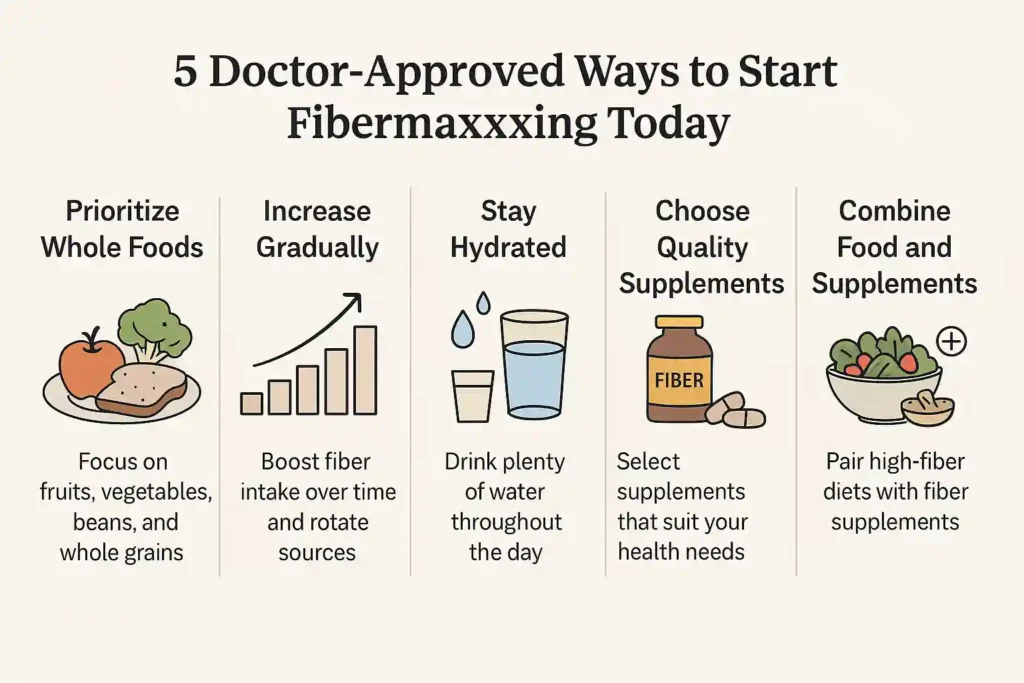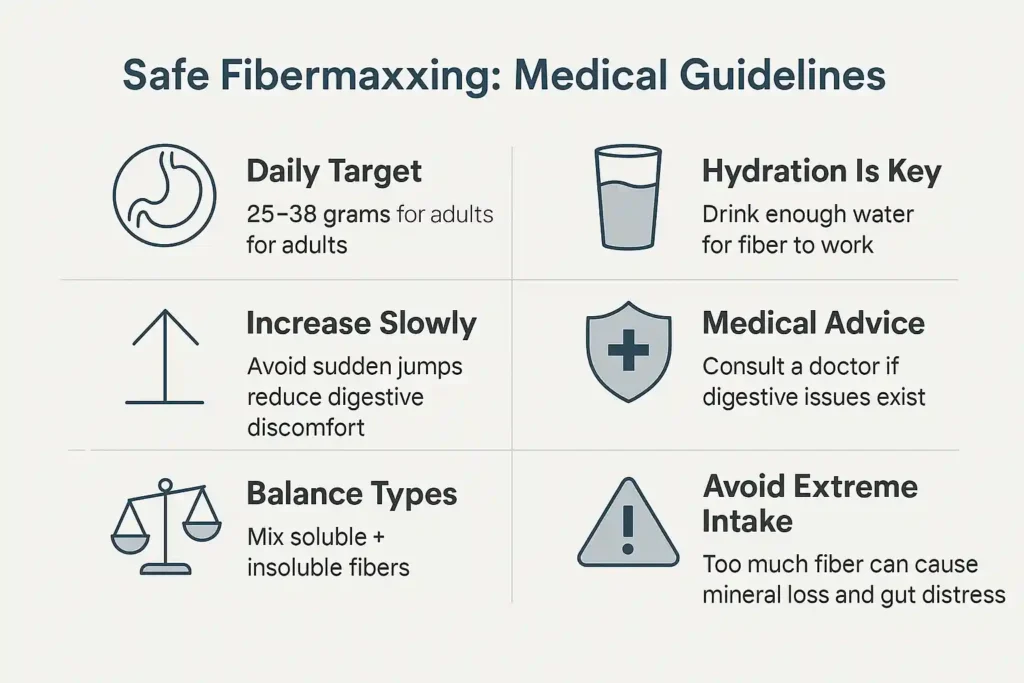What is Fibermaxxing?
Fibermaxxing is the method of purposefully elevating your fiber intake significantly above the norm to optimize health benefits. Instead of getting a little here and there, you make fiber the main nutritional priority.
Table of Contents
ToggleIt’s not just sprinkling some oats on your breakfast, it’s filling your meals with fruits, vegetables, legumes, whole grains, and sometimes fiber supplements . Some people also add the best prebiotic fiber powders to feed beneficial gut bacteria.
Most adults get only half the fiber they need. Experts recommend 25–38 grams daily, but many barely hit 15 grams. That’s where fiber for gut health becomes a focused goal.
The aim is better digestion, weight control, heart health, and even mental wellness, making fibermaxxing more of a real wellness practice than a passing craze.
Health Benefits of Fibermaxxing: What Medical Research Shows
Medical research strongly supports the advantages of fibermaxxing . When you consistently eat enough fiber, your body experiences benefits that go beyond the bathroom.
Better Digestion and Regularity
Fiber adds bulk to your stool, known as the fiber bulking effect , helping prevent constipation and supporting a healthy colon. It can also lower the risk of digestive issues like diverticulitis.
Weight Management
Studies show fiber in weight loss diets helps you feel fuller longer. By slowing down digestion, fiber keeps blood sugar steady and reduces cravings, making it easier to maintain a healthy weight.
Heart Health and Cholesterol Control
Soluble fiber binds to cholesterol in the digestive tract, helping reduce LDL (“bad” cholesterol) and lowering the risk of heart disease.
Blood Sugar Regulation
By slowing glucose absorption, fiber prevents sharp spikes in blood sugar—particularly important for people managing or avoiding type 2 diabetes.
Gut Microbiome Support
The gut flora and fiber connection is powerful, fiber feeds good gut bacteria, which in turn produce anti-inflammatory compounds that strengthen immunity and improve overall health.
5 Doctor-Approved Ways to Start Fibermaxxing Today

If you want to join the fibermaxxing trend without turning your stomach upside down, here’s how doctors recommend starting:
1. Prioritize Whole Foods First — but Plan Fiber Variety Like a Pro
With fibermaxxing , it’s not just “eat more plants”, it’s about choosing specific types of fiber strategically . Different fibers have unique effects:
- Soluble fibers (found in oats, barley, apples, beans) form a gel in your gut, slowing sugar absorption and lowering cholesterol.
- Insoluble fibers (in wheat bran, cauliflower, nuts) sweep waste through your colon, preventing constipation.
- Fermentable fibers (like in garlic, onions, asparagus) feed gut bacteria, improving immunity.
Instead of only picking high-fiber foods, aim for at least two types of fiber in each meal , like pairing oatmeal (soluble) with berries (fermentable) or whole wheat bread (insoluble) with hummus (soluble + fermentable).
This “fiber diversity” maximizes digestive and metabolic benefits.
2. Increase Gradually — and Rotate Sources
A common mistake is jumping to high fiber intake overnight. But here’s the part people rarely mention: your gut microbiome needs time to adapt to each fiber source .
If you eat the same fiber food daily (say, only oatmeal), your gut bacteria population becomes less diverse. Instead:
- Week 1–2: Incorporate lentils into your lunch three times weekly.
- Week 3–4: Introduce chia seeds at breakfast.
- Week 5+: Rotate in beans, leafy greens, barley, or other plant-based fiber sources .
This rotation prevents gas overload from a sudden bacterial bloom and builds a stronger, more resilient microbiome.
3. Stay Hydrated — But Time Your Fluids
The “drink more water” advice is incomplete. For fiber to work efficiently, water should be distributed evenly throughout the day , not gulped all at once.
- Drink a full glass of water with every fiber-rich meal to facilitate the formation of gel by soluble fiber.
- Avoid drinking large amounts immediately after a heavy fiber meal if you’re prone to reflux.
- Herbal teas like peppermint or ginger between meals can help reduce gas from fermentation.
This hydration timing helps fiber travel smoothly without causing bloating or constipation.
4. Choose Quality Supplements — Based on Your Goal
Not all fiber supplements work the same way. The best choice depends on your main health target:
- For cholesterol & blood sugar : Psyllium husk has the most clinical backing.
- For constipation relief foods alternative : Wheat dextrin is gentler for sensitive stomachs.
- For microbiome health : Inulin or partially hydrolyzed guar gum are top best prebiotic fiber options.
Also, choose supplements with no added sugar or artificial flavorings , these can undo some gut benefits by feeding harmful bacteria.
5. Combine Food and Supplements — Strategically
Many people take supplements and still eat low-fiber meals. However, the combination of whole foods and fiber supplements yields superior outcomes.
For example:
- Morning: Oatmeal with berries + 3g inulin powder stirred in.
- Lunch: Lentil salad + whole-grain pita.
- Dinner: Quinoa with roasted vegetables + psyllium capsule.
By spreading intake across the day, you avoid the overconsumption of fiber risks that happen when taking a large dose at once, and your gut bacteria get a steady food supply.
Expert Advice by Dr. Good Deed
According to Dr. Good Deed, a leading nutrition expert:
“The buzz around fibermaxxing is well-deserved. We have decades of research proving fiber’s benefits, yet most people barely get half the daily recommended amount. If you do it smartly, through a mix of whole foods and supplements, you can see better digestion, stable energy, and even long-term disease prevention.”
Dr. Good Deed also warns:
“Don’t chase extreme numbers. Going overboard has no added benefit and can actually lead to overconsumption of fiber risks , such as bloating, nutrient absorption issues, and discomfort.”
Safe Fibermaxxing: Important Medical Guidelines

Before you rush to double your fiber intake, keep these safety rules in mind:
- Daily Target : Aim for 25–38 grams for adults.
- Increase Slowly : Sudden jumps can cause digestive discomfort.
- Balance Types : Mix soluble and insoluble fibers for best results.
- Hydration Is Key : Fiber needs water to prevent constipation.
- Medical Advice : If you have digestive disorders, consult a doctor before increasing fiber drastically.
- Avoid Extreme Intake : More isn’t always better; too much can cause mineral loss and gut distress.
For those with digestive disorders, a history of bowel surgery, or chronic gut problems, fiber changes should be made under medical supervision.
The Bottom Line
Fibermaxxing is one of those rare health trends that’s more real wellness than hype. It’s not about a magic pill or exotic superfood, it’s about a nutrient your body already needs in larger amounts than you’re likely eating now.
By boosting your fiber intake through whole foods and quality supplements, you can improve digestion, control weight, balance blood sugar, and support your gut microbiome. But like any good thing, moderation and smart planning are key.
FAQs
What is fibermaxxing?
Fibermaxxing means deliberately boosting fiber intake above average to improve digestion, support heart health, control blood sugar, and feed beneficial gut bacteria through high-fiber foods and fiber supplements.
Is it okay to take fiber pills every day?
Yes, daily fiber supplements can be safe for most adults, especially when combined with fiber-rich foods. Follow dosage instructions, drink enough water, and choose high-quality, science-backed brands.
How can I get 100% fiber daily?
Eat a variety of plant-based fiber sources, including fruits, vegetables, beans, seeds, and whole grains. Use the best fiber supplement brands if you struggle to meet your daily target through diet alone.
Does fiber make your stomach flat?
Fiber can reduce bloating by improving digestion and preventing constipation. It may help a stomach look flatter by supporting regular bowel movements and reducing water retention in the digestive tract.
Can fiber lower blood pressure?
Yes, studies show fiber for gut health can also benefit heart function. Soluble fiber may slightly reduce blood pressure by improving cholesterol balance and supporting healthier blood vessel function.
Is fibermaxxing safe for everyone?
For most people, fibermaxxing is safe when done gradually. Those with digestive disorders or bowel surgeries should consult a healthcare provider before making big changes to fiber intake.
What foods are best for fibermaxxing?
Excellent options include lentils, chickpeas, chia seeds, oats, pears, broccoli, spinach, berries, and beans. Pair these with the best prebiotic fiber for maximum digestive and microbiome benefits.

This article is medically reviewed by Dr. Nivedita Pandey, Senior Gastroenterologist and Hepatologist, ensuring accurate and reliable health information.
Dr. Nivedita Pandey is a U.S.-trained gastroenterologist specializing in pre and post-liver transplant care, as well as managing chronic gastrointestinal disorders. Known for her compassionate and patient-centered approach, Dr. Pandey is dedicated to delivering the highest quality of care to each patient.








